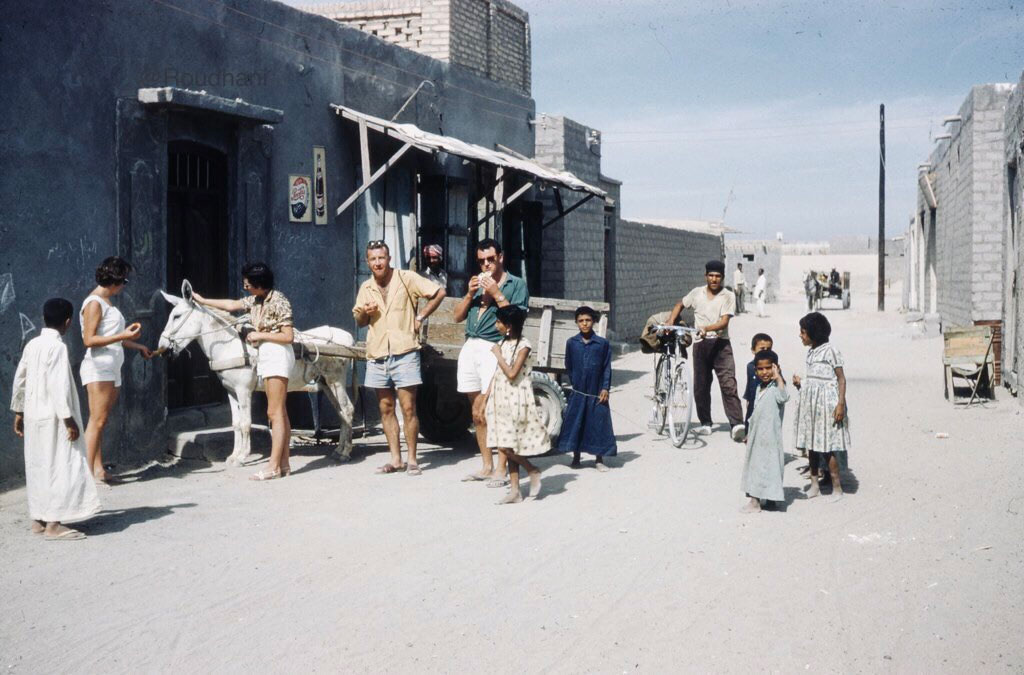
American tourists visit Al Mangaf city back in 1961.
via @Roudhani
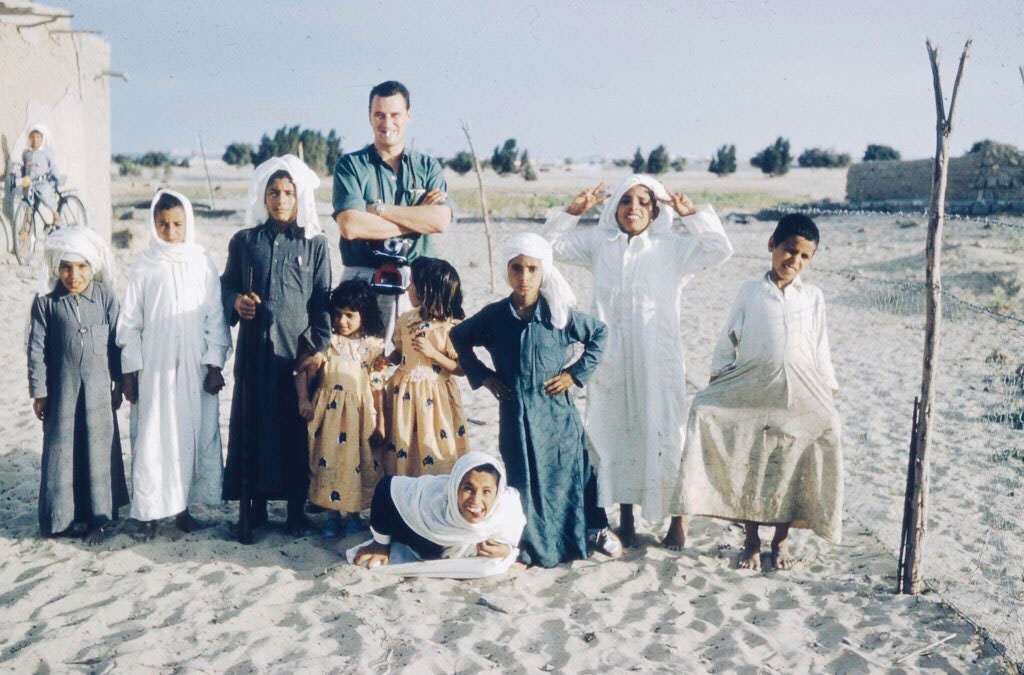
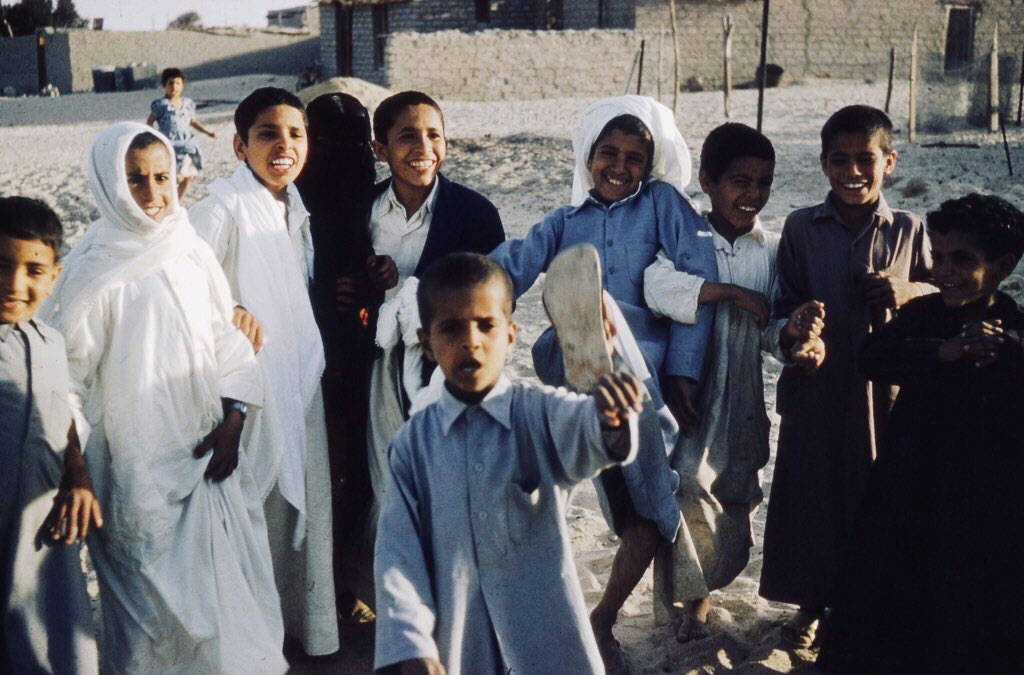
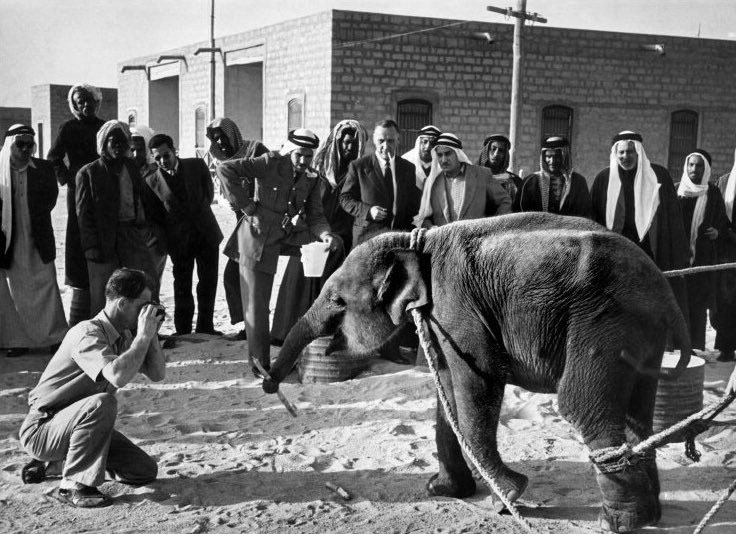
Found this photo on a twitter account with the caption “First elephant in Kuwait for the zoo – Kuwait 1952”. I’m not sure which zoo though since the current one opened up in 1968, so could be some other zoo that was open back then (did Ahmadi have a zoo?) or maybe it was part of a traveling circus? Still cute though.
via Bader AlRoudan
Update: Supposedly there was a zoo called the Salwa Garden, and it was the first zoo in Kuwait and the GCC. Trying to get more info on this now.
Update2: Check out the snippet below
Not many visitors to the Zoo at Omariya know that Kuwait was the first country in the Gulf where a zoo was established، in 1955. And even less people will remember that it was Shaikh Jabir Al Abdullah Al Jabir Al Sabah who set up the region’s first zoo known as Salwa garden، after which the place Salwa was so named subsequently. He purchased animals، with his own money and eventually transferred his collection in 1965 to form the nucleus of Umariya Zoo.
The long and moving story has been told in the book titled “Salwa Garden: the first zoo in Kuwait and the Arabian Gulf” written and published by his daughter Shaikha Mona Jabir Al Abdullah Al Jabir Al Sabah، Assistant Undersecretary of Al Diwan Al Amiri and author of several research-oriented books on Kuwait and the Gulf. Source
Update3: How am I just finding out about this? The picture below is of the entrance to the zoo and you can see a couple of more photos here.
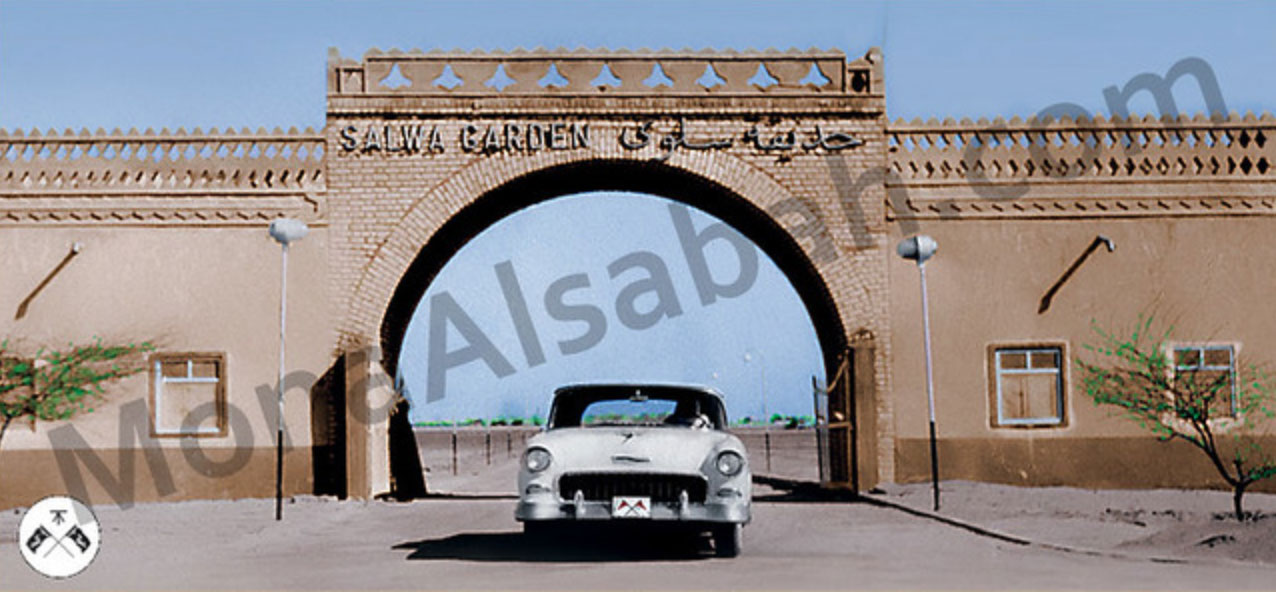
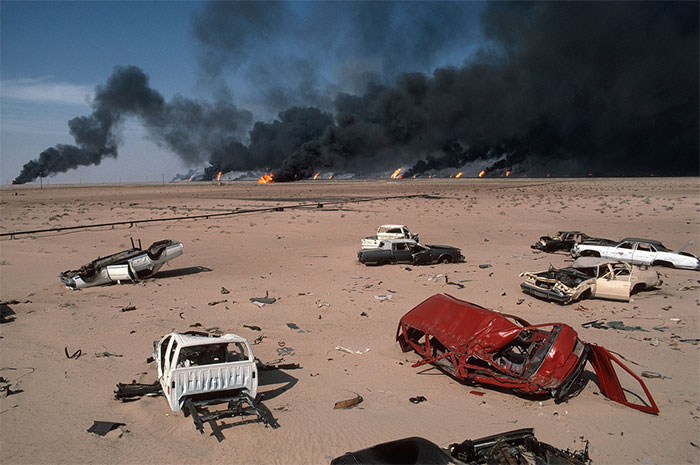
Tomorrow is the anniversary of the 1990 Kuwait Invasion, and every year on the anniversary, I like to share some links related to the war. This year though I noticed two of my favorite websites related to the invasion are no longer up and running, Free Kuwait and The Evidence.
Both those website contained a large archive of photos related to the invasion and I’m pretty upset that they’re both no longer working. I’ve already emailed the people behind those two websites to see what the issue is, hopefully, it’s just a technical hiccup but in any case, below are the rest of the links.
Free Kuwait
This is a website that focuses on the campaign that was led by Kuwaitis in exile and is loaded with photos and information.
Kuwait Invasion – The Evidence
This is a website that contains over 1,200 pictures taken right after the 1990 invasion as photographic evidence to all the destruction caused by Iraq.
Short movie: Hearts of Palm
Hearts of Palm is a short movie set in August 2nd 1990 and deals with Kuwaiti students living in Miami Florida during the Iraqi Invasion of Kuwait.
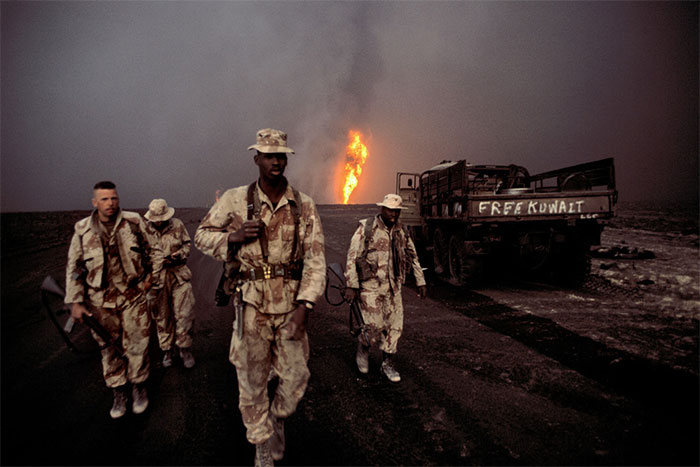
The Class of 1990
This is a short documentary about reuniting class mates years after the 1990 Iraqi invasion.
Homemade video from the Iraqi invasion of Kuwait
Video clips taken by a Kuwaiti family during the Iraqi invasion
Desert Storm Photos
Photos taken by soldiers during Desert Storm.
Short Animation: Sandarah
A captivating story based on true events that took place during the 1990 Iraqi invasion.

First Account of Iraq’s Invasion of Kuwait
Interviews with various Kuwaitis that were in Kuwait during the 1990 invasion.
Iraqi Invasion Pictures
Photos of the Gulf War aftermath.
Politics of Wor
A tumblr account with some not so commonly seen photos from the Gulf War. (Warning some are graphic)
Magnum Photos
A gallery of images taken during the Gulf War by some great photographers. (Warning some are graphic)
BBC Documentary: The Last Flight to Kuwait
A series of documentaries on Iraq begins with a look at the fate of British Airways flight BA149 to the Far East in 1990. As the plane landed in Kuwait, Saddam Hussein invaded, capturing its crew and passengers.
Photos in this post are by Bruno Barbey
Update: I just bought a hard copy of the books The Evidence and Evidence II which is what the website The Evidence is based off. Now looking for “A Testimony from London” which the Free Kuwait website is based on. If you know where I can find it let me know.

While at the National Library recently, I found a few newspaper clippings related to James Brown when he visited Kuwait back in 1978. I was hoping to find more coverage in the papers but I searched through 1 month worth of AlQabas newspapers and only found a few ads and one article. I’m gonna go back and try to look for more in other newspapers but for now, I’m gonna share the ones I found. One is on top and the rest are below. If only the library didn’t have the most impractical opening hours…
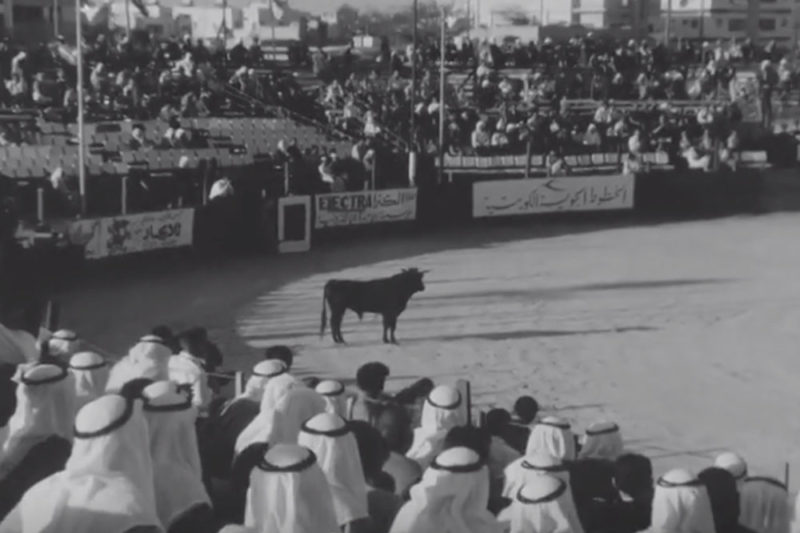
Over the weekend a video started making its round via social media of a bullfight that took place in Kuwait back in 1972. The video was fairly low quality and the audio was completely broken so I did a bit of research and turns out the original video is actually owned by Reuters and you can watch the longer and much better version on their website.
According to Reuters, the bulls were imported from Spain for this event which was the first ever bullfighting show in Kuwait. The video is from the show that took place on Thursday April 6, 1972 but there were two other shows that took place on Friday 7th and Saturday 8th of April. Below are some more details:
A Spanish bull faced Spanish matadors in Kuwait on Thursday. It was the first time the Arabian Gulf state has seen a bull-fight. The event was organized by the Salmiya Sports Club and sponsored by the Kuwaiti Minister of the Interior and Defence, Shaikh Sa’ad Al-Abdalla As-Sabah.
A large crowd of spectators packed into the arena to see the novel exhibition of bullfighting skills and physical courage. Among those watching were the Speaker of the Kuwaiti National Assembly and other Assembly members. The event was much enjoyed by the spectators.
Aficionados in Spain may know more about the technicalities, but in Kuwait the crowd understood well enough the perfect judgment needed to plant these darts in just the right place.
The show had opened with the playing of the Kuwaiti and Spanish national anthems and the grand entrance of all the bullfighters. There was no doubting the success of this first bullfighting spectacle in Kuwait. Other shows were scheduled for Friday and Saturday.
So if you want to watch the video, click here.

I recently found out that it’s the British School of Kuwait’s 40 year anniversary. What not everyone knows is the little fun fact the school used to be called Sunshine School when it first opened in the late 70s up until 1990. I was in Sunshine School from 1980 to 1990 and I was part of the last class to graduate from it before the Iraqi invasion, after that, things got a bit messy and I ended up bouncing a lot from school to school and country to country until I finally graduated high school.

Because of the 40th anniversary, the school is publishing a small book and asked me if I had any photos to contribute since I’ve previously shared photos on the blog. I did of course and so had my sister mail me all the Sunshine School photos we had stored in our family home in Lebanon so I could scan them.

What’s cool is I posted some of my karate club photos taken in the early 80s and one of my followers recognized the karate instructor and sent me a link to his Facebook account. Turns out up until recently, he was still teaching karate in Kuwait.
There are 58 pictures and you can check them out after the link below. If you want the hi-res scan they’re also available to download on Flickr.
If you recognize yourself in any of the photos let me know!
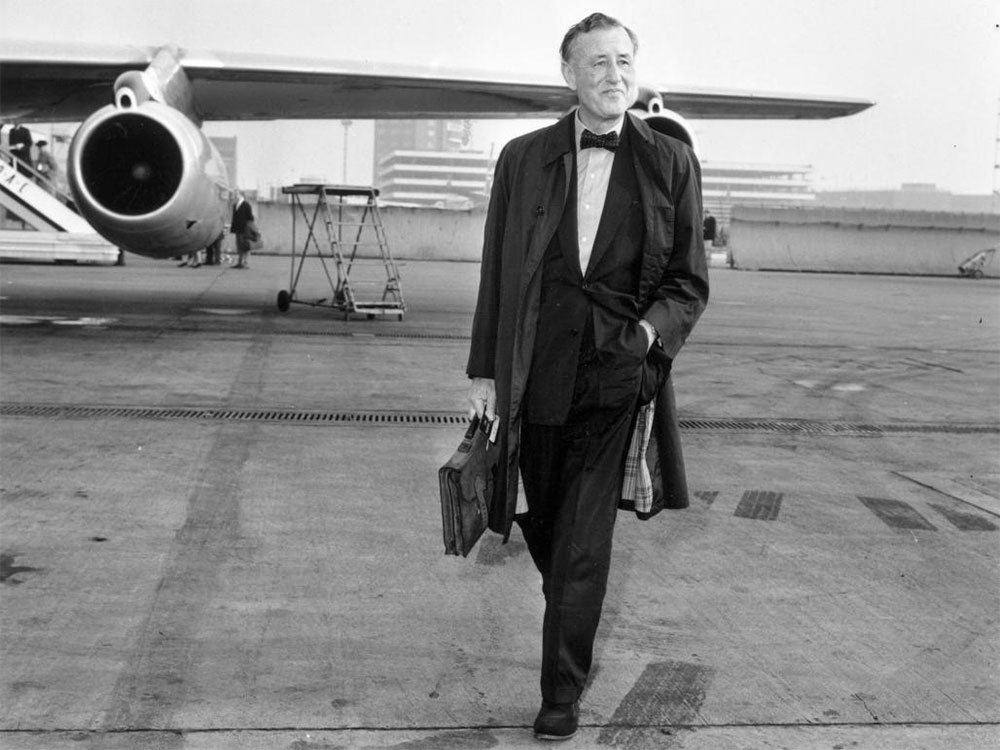
This is a long shot but does anyone have a copy of the book “State of Excitement” by James Bond creator Ian Fleming?
The Kuwait Oil Company commissioned Fleming to write this short book about Kuwait. However, the Kuwaiti Goverment disapproved of the final manuscript, which they found condescending, and the book was never published, despite repeated overtures to the Kuwaiti Goverment over the years.
The frontispiece to Fleming`s copy of the book reads: This is the only bound copy of a short book I wrote on Kuwait in December 1960. It was a condition of my obtaining facilities to visit Kuwait and write the book that the text should have the approval of the Kuwait Oil Company, whose guest I was.
The Oil Company expressed approval of the book but felt it their duty to submit the typescript to members of the Kuwait Government for their approval. The Sheiks concerned found unpalatable certain mild comments and criticism and particularly the passages referring to the adventurous past of the country which now wishes to be “civilised” in every respect and forget its romantic origins.
Accordingly, the book was stillborn. [source]
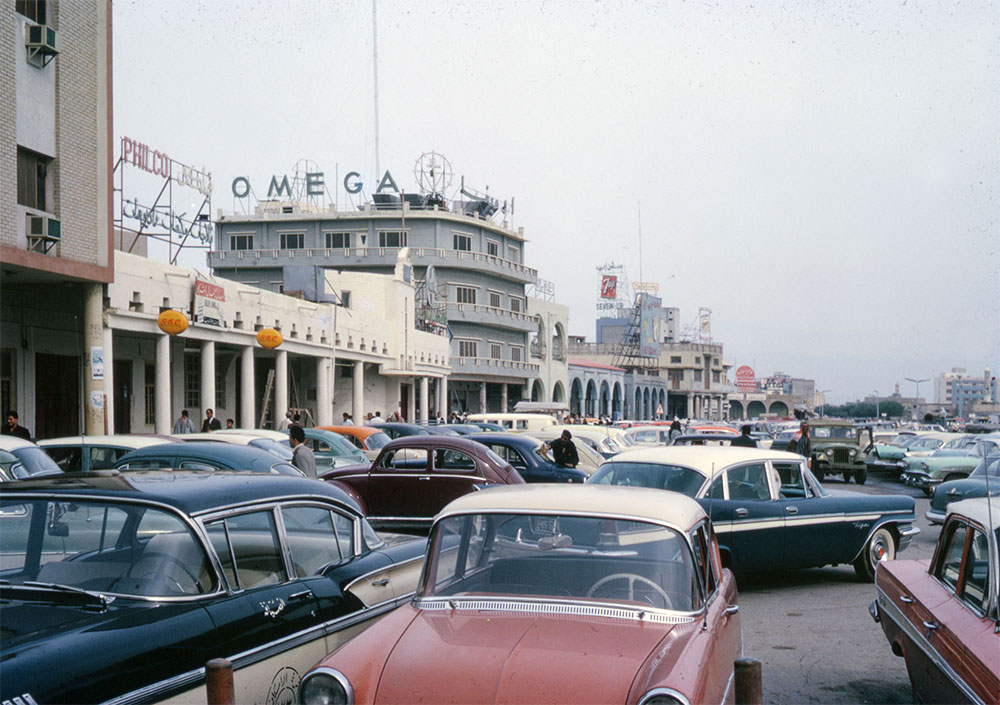
Here is a review of the book as well where they highlight some reasons the book might have been banned including this one:
A second rather humorous story the author relates revolve around an invitation he received to dine at one of the Sheikh’s numerous palaces. It seems that this palace located somewhere along the Persian Gulf coast had a very long dock which extended out far from land and at its end was a beautiful building where the Sheihk invited Fleming and other guests. In grand fashion the guests were carried from the shore in a stretch limousine out along the dock to the mini-palace. He noticed that after the guests had been dropped off, the driver had to back up the entire length of the dock, turn around and then back up the entire length of the dock once again. Fleming surmised that the driver was instructed to do this so that when the dinner was finished, the Sheikh and his guests could get back into the car on the ‘correct’ side and drive “forward” back to the shore. Fleming, almost snidely relates that even with all that money at his disposal the Sheikh couldn’t design and build a dock with a wide enough turn around. In other words, in this little vignette Fleming is mocking his host’s design and thereby his intelligence.
If you have a copy can you please accidentally leak it to me from an anonymous email address? Thank you!
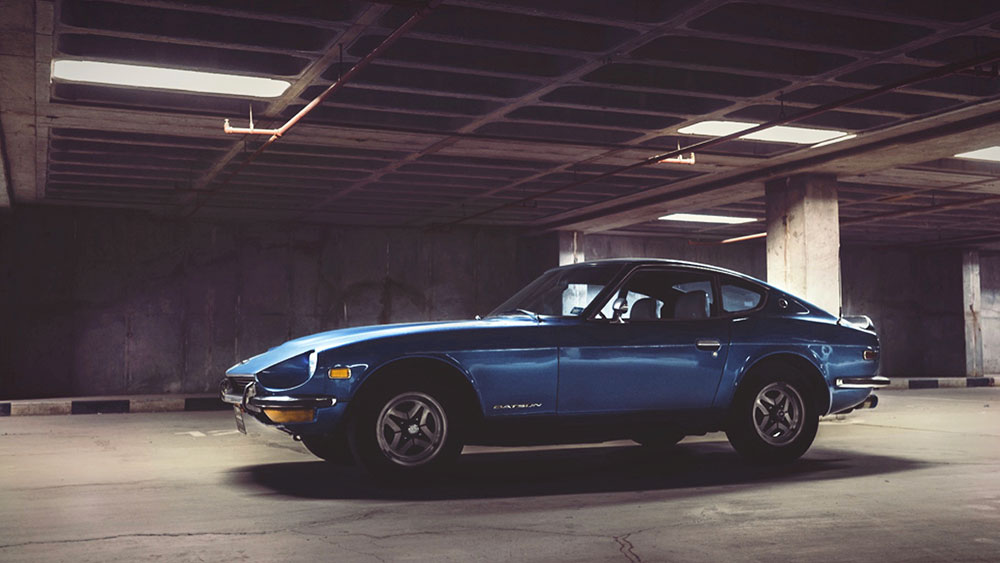
Back in 2016 I bought a 1973 Datsun 240z. I used to really love that car and fixed it up so I could daily drive it and I was doing so until I decided to buy my first Lotus. I ended up selling the 240Z to a friend of mine so I wouldn’t feel too guilty about spending so much money on the Lotus, and I always regretted it. What’s worse is that he offered to sell it back to me at the end of last year, but I said no because I was in between jobs and that wouldn’t have been the responsible thing to do. By the time I realized my mistake, the car was sold off to another friend of ours who sent it to Bahrain where it’s getting a full restoration job.
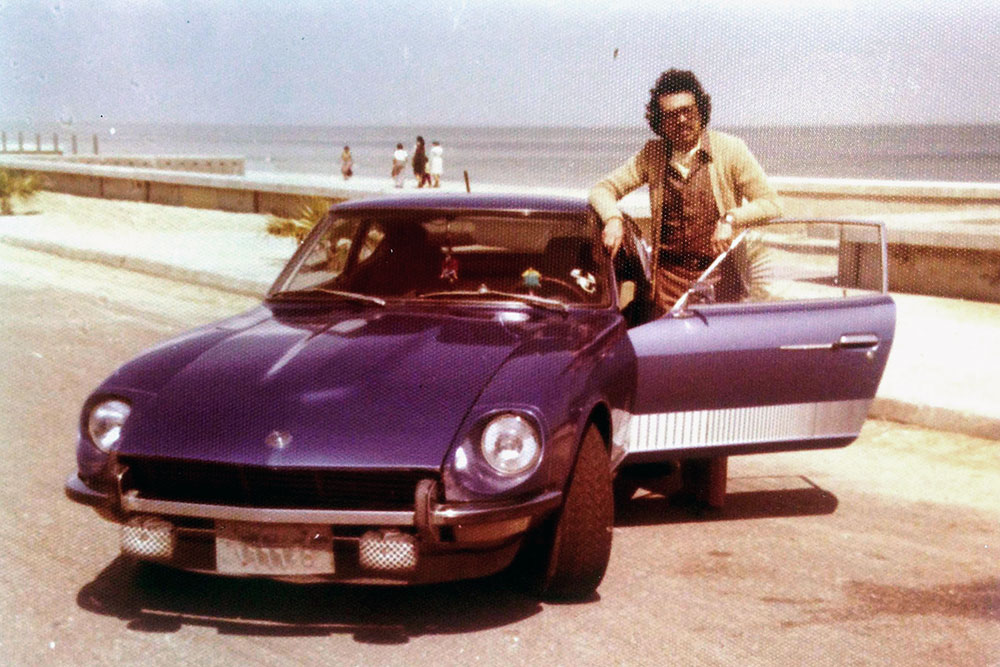
I really needed a classic car in my life and I tried to find something interesting locally but couldn’t, so I started looking outside of Kuwait. I eventually ended up finding a beautiful red 1970 Alfa Romeo GTV in Holland and bought it back in April. But that car is still in the process of getting registered for export in and then needs around a month to get to Kuwait. So while waiting for it I kept my eye open for a 240z and a couple of weeks ago I finally found a good one that was located in Sulaibiya. It was blue like my dad’s Datsun in the 70s, and the guy was asking a reasonable price for so I went and checked it out.
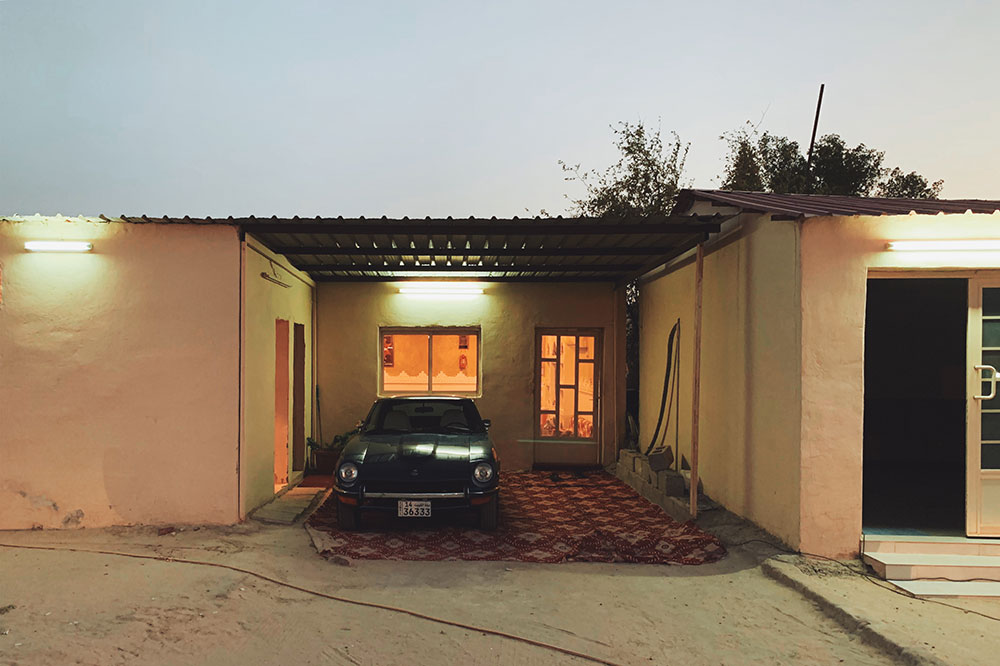
At first glance, the car didn’t look like much, and I think that’s what might have scared other buyers off. The seats were ripped, the interior had been fully carpeted by the owner covering up all the original diamond stitched vinyl that covers the interior, and the original engine was swapped out with a 280z engine. But, the dashboard with all the dials and knobs was super clean! It was in much better condition than the one in my older Datsun and it’s actually the most expensive thing to restore in the car. Everything else like the seat covers, interior vinyl trimming, carpets, plastic panels etc.. are readily available and not for much. But a new dashboard without any of the dials and different buttons on it? That would easily cost you a third of the price of the car. The whole dashboard and center console area looked like it was refurbished or swapped out with a new one by one of the previous owners, so I quickly realized this was the car to get. Even the fact that the engine was off a 280z was a good thing for me because it meant I could install air conditioning and more engine parts were available for it.
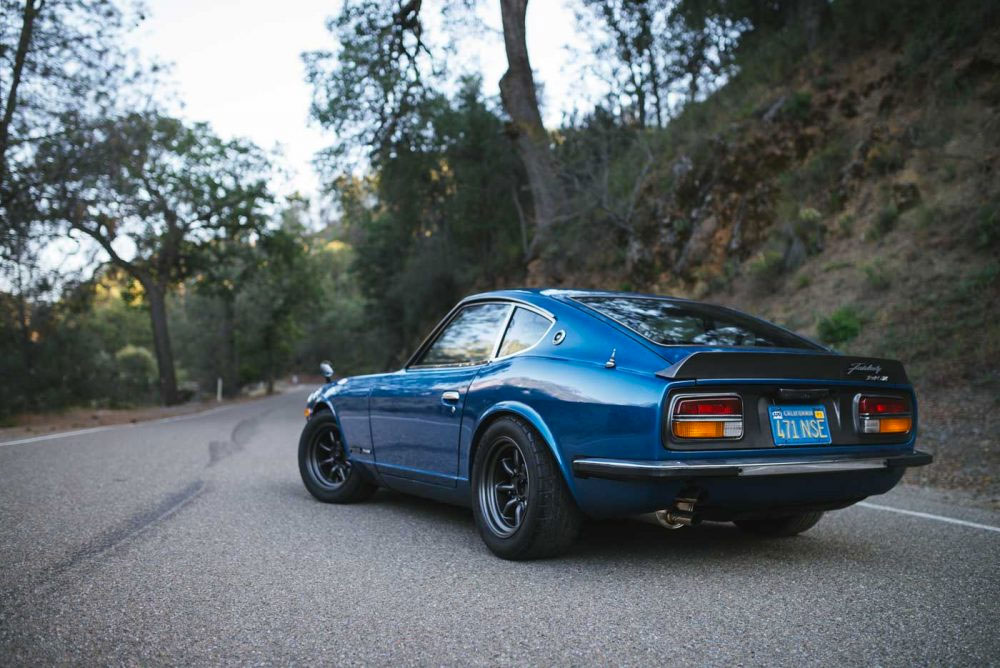
So now I’m a proud owner of a 1972 blue Datsun 240z. I spent the weekend ordering a whole bunch of parts for it and I already scheduled an appointment with my mechanic to start work on it. By the time I’m done it should hopefully look similar to the 240z pictured above which was featured on Petrolicious. I’m super excited!
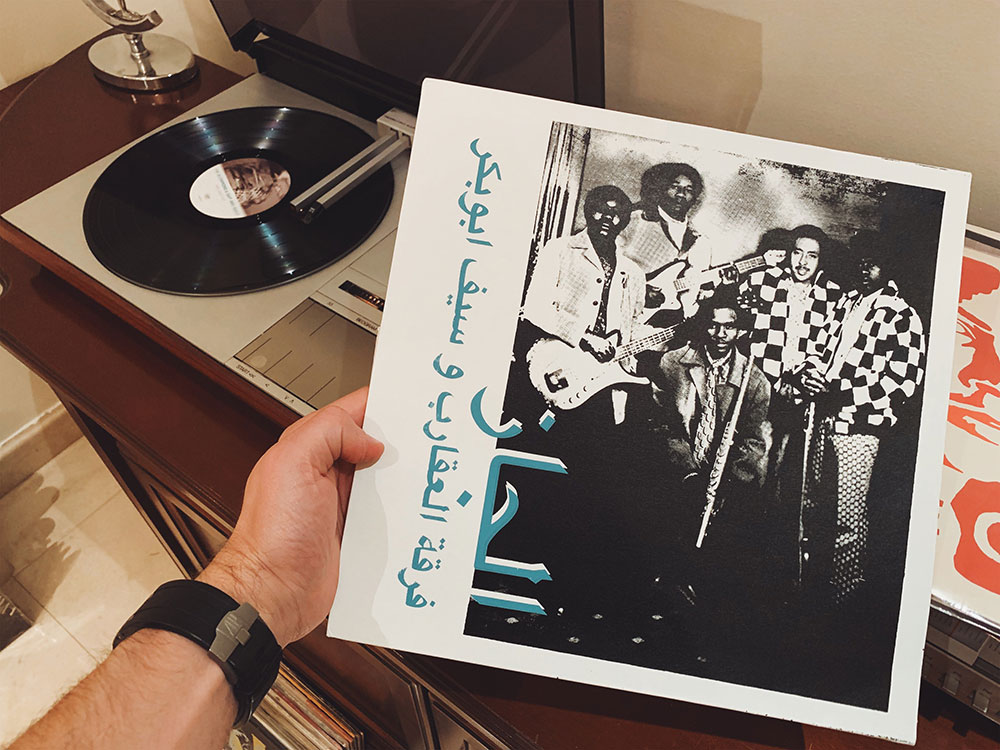
This is going to be a fairly long post but trust me, if you love nostalgic Kuwait related posts you’re going to want to read this because it’s just so random and really interesting.
A couple of weeks ago I was over at the Australian ambassador’s house (Jonathan) who is a music buff and while there he showed me a record which he knew I’d be interested in. The album was called “Jazz, Jazz, Jazz” by a Sudanese band called The Scorpions & Saif Abu Bakr and inside there was an interview with the band members. Turns out the band used to perform in Kuwait back in the 70s at different venues including the Hilton Hotel, the Sheraton Hotel, and the Marriott Hotel. Check out the clipping below:
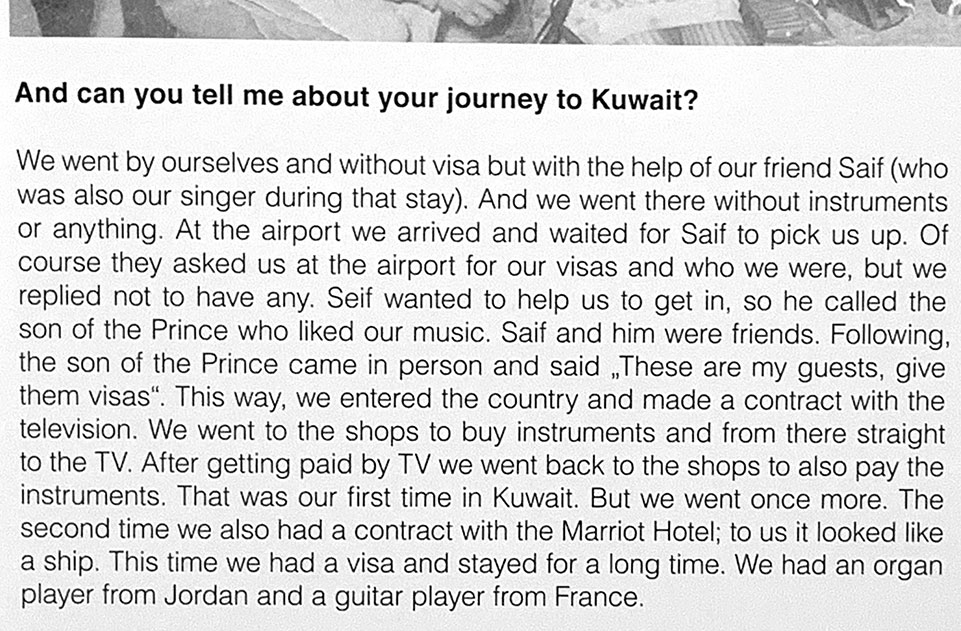
And can you tell me about your journey to Kuwait?
We went by ourselves and without visa but with the help of our friend Saif (who was also our singer during that stay). And we went there without instruments or anything. At the airport we arrived and waited for Saif to pick us up. Of course, they asked us at the airport for our visas and who we were, but we replied not to have any. Saif wanted to help us to get in, so he called the son of the Prince who liked our music. Saif and him were friends. Following, the son of the Prince came in person and said “These are my guests, give them visas”. This way, we entered the country and made a contract with the television. We went to the shops to buy instruments and from there straight to the TV. After getting paid by TV we went back to the shops to also pay the instruments. That was our first time in Kuwait. But we went once more. The second time we also had a contract with the Marriot Hotel; to us it looked like a ship. This time we had a visa and stayed for a long time. We had an organ player from Jordan and a guitar player from France.
That KTV performance is actually online and you can check it out below:
So this is where things get even cooler. I get all excited about this and start taking photos of the record album and posting them on my Instagram account. A couple of hours later I get a message from a follower saying:
This is so weird. Saif is a colleague of mine and seeing this and reading it, it just seems like it’s another dimension. We knew that he was a part of some band, we just didn’t know to what extent. Where can I get this record/Cd?
Saif was still in Kuwait?? I quickly shared the message with Jonathan who suggested we invite him to dinner. So I had Saif’s colleague talk to Saif and see if he would be interested to meet. I ended up getting his contact information and Jonathan set up the dinner for us.
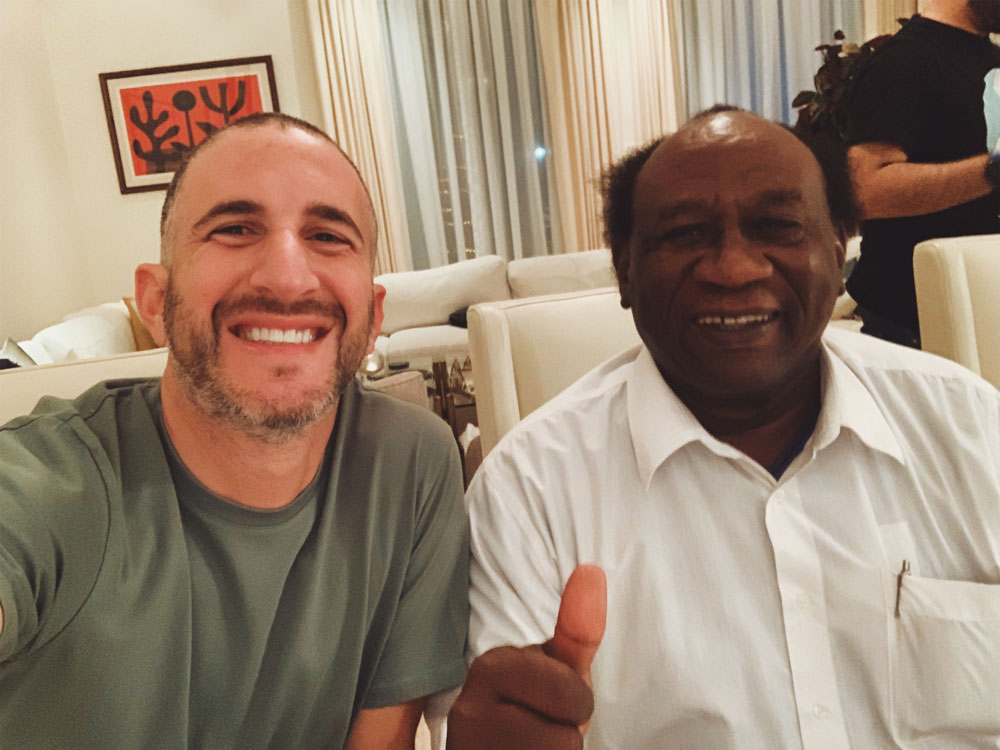
Me with Saif
A few days later we got to meet Saif and he was just full of interesting stories. Saif was never meant to come to Kuwait, when he turned 18 he decided to leave Sudan and head to Germany. So he headed to Lebanon first so that he could take the train to Germany. Once he got to Lebanon he met a girl and so decided to stay there for a month, he needed the money anyway and he figured he could earn money performing music while there. He then left Lebanon and headed to Syria and from there he got convinced to head to Kuwait and try and earn money there.
Once in Kuwait he met up with an old friend of his called Adam who used to play football for Qadsia club. Adam hooked Saif up with a job as an English teacher for air traffic controllers and as a side gig, he would perform music on Kuwait TV talk show. One day one of the guys at KTV comes up to him and asks him if he could put a band together because he wanted to record a performance for the station. Saif tells him he could and called up his friends in Sudan whom he used to perform with called The Scorpions. That’s basically how the whole story with that KTV broadcast came to be.

The Scorpions & Saif Abu Bakr Performing at KTV
But that’s not the end of it. Saif used to perform for a Kuwaiti event organizer back then called Hussein Abul. Hussein was the guy who brought the likes of Boney M, Demis Roussos, James Brown and Santa Esmeralda to perform in Kuwait. When James Brown came to Kuwait, Hussein gave Saif the job of driving James Brown around since Saif spoke both English and Arabic. Since Saif spent a lot of time with James Brown, a friend of his told him to ask James Brown if he could perform the track Super Bad at his events. The first two nights James Brown performed he didn’t play Super Bad but it was a really popular song with the locals and so a lot of people were requesting it. So Saif explained that to James Brown who said he didn’t mind. During rehearsal that day, James Brown tells his band that he wanted to play Super Bad but, one of the two bassists in the band didn’t know how to play it. James Brown tried to help him out by humming the rhythm he wanted but the bassist couldn’t get it right. Out of frustration James Brown asked his band if anyone else knew how to play the bass on Super Bad, and Saif who was sitting there watching the whole thing said he knew how to play it. James Brown was like are you sure you know how to play it? Saif and his band used to perform covers all the time and he used to practically play Super Bad every night at hotels. So even though he was under pressure now to perform in front of James Brown, he knew the song inside out. He ended up playing for James Brown who was so impressed that he asked Saif to perform the song with the band over the remaining events in Kuwait.
One interesting fact I found out, Hussein had also supposedly signed a contract with Michael Jackson to come to Kuwait. But before Michael Jackson’s event, he had scheduled the popular band Osibisa to come to Kuwait as well. But Islamists caused an uproar over one of Osibisa’s tracks because it contained an Islamic verse or something like that, and Hussein was banned from organizing events ever again. Hussein supposedly ended up leaving to Brazil where he now lives permanently.
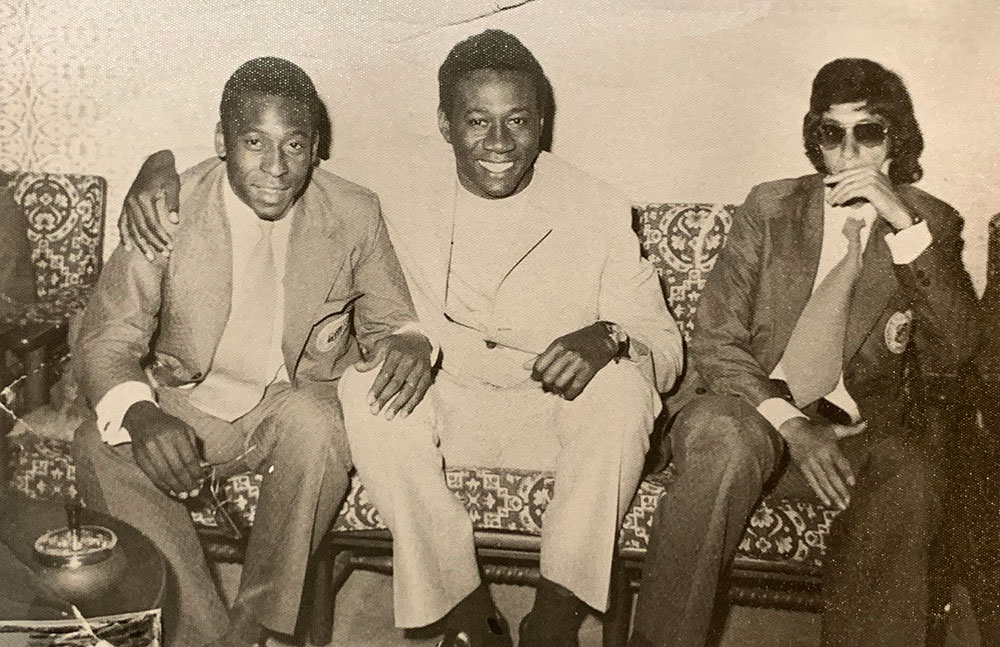
Saif with Pele in Kuwait
Anyway, Saif eventually ended up leaving Kuwait to study but then came back once he was done. He’s been in Kuwait ever since and currently still teaches English at a local aviation school but still performs in Sudan every now and then with his old band. He lost most of his old photos during the 1990 Iraq invasion but I shared two remaining ones in this post, the Pele photo above and the band performing at KTV above that. Jonathan the Australian Ambassador is also gonna try and bring the band together again to perform in Kuwait and once that happens I’ll let you guys know.
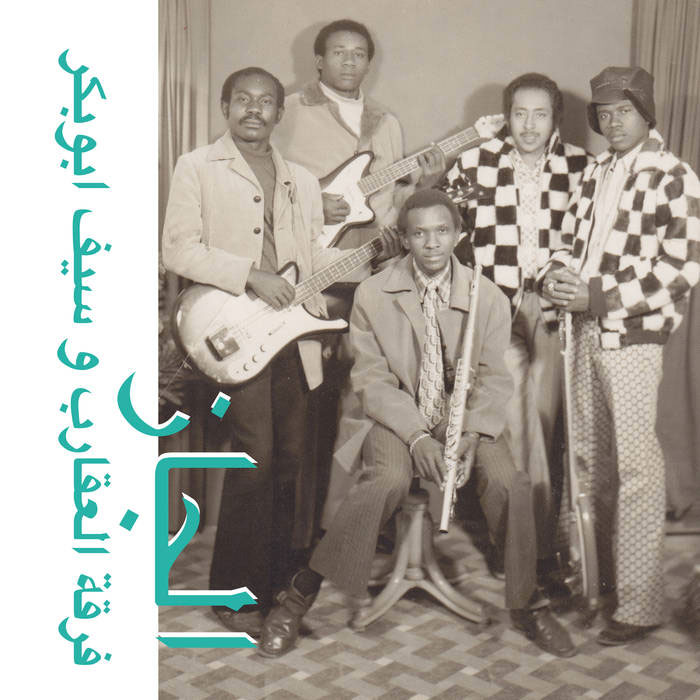
For now if you’re interested in buying a copy of the album “Jazz, Jazz, Jazz” it’s available for purchase in different formats on bandcamp.
Update: Jazz, Jazz, Jazz is also available on Spotify. Farrah Galbi Aljadeed is my favorite track followed closely by Forssa Saeeda.

I found some scans on The Sultan Gallery’s instagram account taken from The Andy Warhol Diaries with not-so-flattering comments from his visit to Kuwait which I thought would be interesting to share.
Andy Warhol came to Kuwait in 1977, invited by the National Council of Arts, Culture, and Letters, and an exhibition of his work was held at the Dhaiat Abdullah Al Salem Gallery on January 18, 1977. Fred Hughes, his manager, accompanied him from the States, along with James Mayor of the Mayor Gallery in London. [Source]
I managed to get his entries typed out to make it easier to read and you can check them below:
Saturday, January 15, 1977 — London — Kuwait
Up at 7:00 for the flight to Kuwait. Tired. Packed, showered. Looked for crabs, still. Sent the hotel bill to the Mayor Gallery (tips at hotel $10). Picked up James Mayor at his place. He’d gotten us second-class seats, I was really mad. but there was one first-class one and I got it. Kuwait Air. The plane had to stop at Frankfurt and lots of people got on there. Read The Users by Joyce Haber, very boring, about a homosexual husband. Joyce was married to Doug Cramer, he’s a producer. There was a sheik on the plane up front with bodyguards in an even further front cabin. Took a pill. Fell asleep.
Woke up when the plane was landing. Arrived 11:00 late at night. Met at the airport by some Arabs. There was a girl Nadja, from the Council for Culture, who’d arranged the show. They made us drink some strange coffee at the airport.
Sunday, January 16, 1977 — Kuwait
Up at 9:30. Breakfast toast and tea (tip $2. laundry $1). James called. meeting downstairs at 12:00. We were taken to a place that looked like some dump, but then everything here does, and it wasn’t until days later that we realized it had been a chic place. Outside the sun was warm with a lot of cars going by—big Rolls Royce, big American cars. They gave us two cars but we only used one. Went back to the hotel to try to buy A-200 to kill the crabs.
Bought Nick Carter Mysteries ($4). At 4:00 had to meet Nadja and James again. Went to souk for local color. Ladies in black hiding their faces, big marketplace, bazaar. It got very cold. Got an outfit to give to Victor as a gift (hat $4, dress $26). Spent time looking for antiques, but there are none in Kuwait—just a few old pots from a couple of years ago. We were the only foreigners in the marketplace.
Went to Nadja’s gallery. Had some more of the sweet funny coffee they offer you all the time, you go crazy. We didn’t know that if you don’t shake your cup they keep pouring it in.
Bought five more copies of the Kuwait Times ($1). Calligraphy beautiful, no Pop there. Went to different drugstores looking for A-200. To hotel. Ordered dinner before dinner (tip $2). The people we were having dinner with sent a silver Cadillac limousine. Arrived at Qutayba al Ghanim’s, a rich young Peter Brant type. His house was on the gulf, a little out of town. Land there was really expensive. He made it chic by moving there.
Kuwaitis don’t serve hard liquor or beer or anything, it’s against the law, but the rich ones have some hard liquor. Jack Daniel’s or something.
Read Nick Carter. Really good—sex and girls.

Monday, January 17, 1977—Kuwait
Visit to the National Museum, there’s no history to this place, it goes back twenty-five years. There were like eight rooms, one had three coins in the whole room. Think there was one room that Alexander left some pots in. Alexander the Great—three pots and four coins. A room with yesterday’s dresses. More tea and coffee with the director. Just sat there, there was nothing to do. Carred over to see the secretary-general of the Council for Arts for more tea and coffee and ceremony. Dirty handprints on the wall, as if they killed somebody and it was a work of art or something. Guys standing around.
Everybody says the same routine: Where are you staying? How long have you been here? How long will you be here? When are you leaving? When are you coming back?
Carred over to see a rich collector named Fahad al Dabbous. Chubby and cute. He had a lot of paintings around on the wall, some Dalis, one sort of big one, lots of male friends there, most in costume, a couple of wives. They had drinks there, also—only the rich, remember? A big spread on table, nothing compared to Iran’s big spreads. The men looked fat, but usually in costume you couldn’t tell too much. But this one was chubby. He had bought the Marilyn and the Flower prints. He was wearing a girl’s diamond-studded watch with a blue face. The Kuwaiti food was greasy—greasy roast.
Bought crab soap ($6). At 8:00 we were picked up by Mr. Bater, who was the cultural attache from the United States to Kuwait, and taken to see the American Ambassador Morandi who was giving us a dinner. His wife was from Seattle, talked so much it drove us crazy. They were Democrats. Dinner was served at 10:00. Left at 12:00, bored. Used the crab soap, it didn’t work. Fell asleep in the bathtub. In bed couldn’t sleep. Read the Ruth Kligman book again, she was driving Jackson Pollock crazy in the car and that’s when he ran into the pole. Gave it to Fred to read.
Tuesday, January 18, 1977—Kuwait
Up after restless night at 9:00 (tio $1, laundry $2). James Mayor urgently calling—we were always late because it was always so boring we weren’t in a hurry. Visited a Kuwaiti artist atelier. Three artists in each room. This time tea or orange pop. Visited each stall, had to. One guy painted in Picasso-Chagall style. Not one original style. They sit on the floor and paint on rugs and pillows, it looked like hippie streetwares, like the sixties. It was the only nicely designed building in Kuwait because it was a copy of the Ford Foundation. Got a tour of the building. The man said it was very Kuwaitian.
Picked up at 4:30 for the opening of the exhibition in the Arts Council Hall. We had to meet the minister of state there. I think his name was Ahmad Al-Adwani—have that name written down. But maybe that name goes with someone else. I had sent him a copy of the Philosophy book [see Introduction] and he said he’d read it and that it had clever ideas, he was old and cute. There was a red ribbon in front of the door. I had to carry a pair of gold scissors on a red pillow to cut the ribbon. A lot of TV and press there.
Wednesday, January 19, 1977—Kuwait
Went to the exhibition for a tea party and had to drink more tea and then we were invited by the English ambassador to drop by. His daughter was there, she was seventeen and drew cartoons about fags. She was cute and funny. Had her father’s chin, which was no chin. There were a lot of English people there who’d been living and working in Kuwait for years. Left. Big rainstorm.
Picked up by Nadja and had a fight with Fred about not going to Germany. He said I had to go because “you’re a fading star there.” It was the way he said it that got me mad.
Dinner at Nadja’s house. ‘There were sixty people. The best party the whole trip. She had eight or ten brothers and a mother and sisters and all the men dance together, looks like the twist. The food was really good. Then men began dancing with Fred. Someone gave him $40 for dancing so well. Had to stay until everybody left-2:30. James admired somebody’s robe and they gave it to him. Jed admired someone’s nose ring and he got it. I didn’t know about the custom, so I didn’t get anything.
If you’re interested you can check out his full programme from his visit on Bidoun.org.
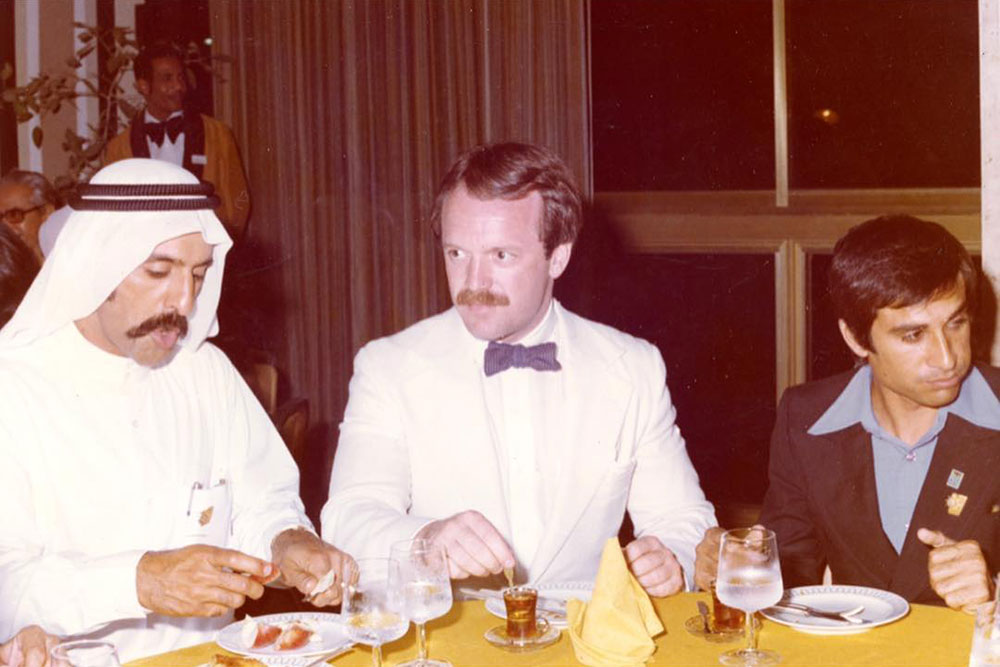
I stumbled upon the instagram post below the other day by the textile designer Christopher Hyland and thought it was worth sharing:
The 1970’s art scene in Kuwait was exhilarating.
Assuming my memory serves me correctly as to date, in 1977 or so the Kuwaiti Ministry of Communication invited me to judge the Kuwait National Art Competition, exactly why and how I cannot remember.
While in Kuwait I attended a Warhol exhibition in a large tent (although Google reports that it took place in the confines of the Sultan Gallery), had breakfast with I M Pei and at the arts awards ceremony I was presented a medal cum Kuwaiti memento of appreciation for my judging efforts (see the accompanying images of the medal and of me seated at dinner with the artists). The arts scene was flourishing.
I met Members of the Al Ghanim family and the owners of the pioneering Sultan Gallery.
Artists organized a weekend, tented desert encampment for me. I recall that the Minister or was it Director of the Ministry of Communications had the-unusual for Kuwait-nickname Bucky Beaver.
One hopes that a vibrant Kuwait arts scene continues to flourish, war and other pressures having so much in the event lessened but not by any means removed the prospects those golden years held. -CH
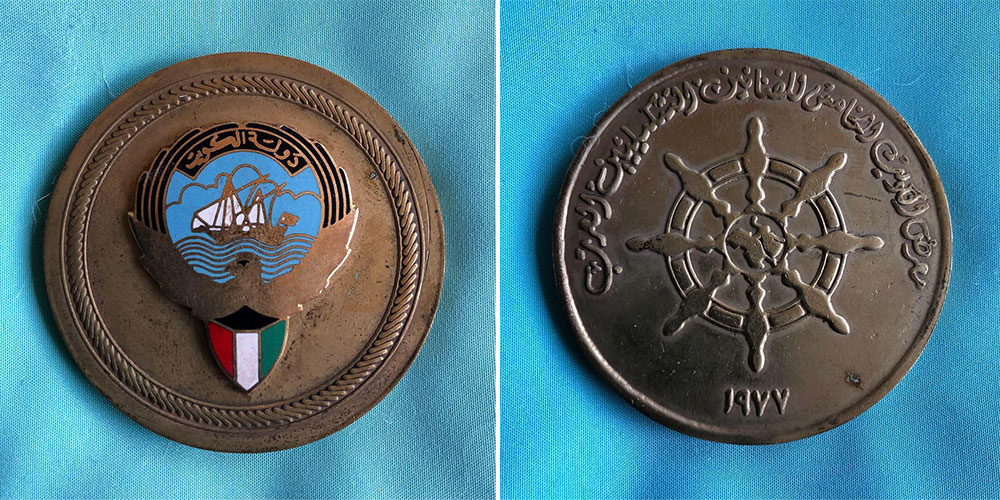
Sultan Gallery also responded to the post with this extra tidbit of information:
Thank you for posting this, it brings back nice memories of Kuwait back then. Just to correct one of the points in the post, the Andy Warhol exhibition wasn’t shown in a tent it was at Dhaiat Abdulla Al-Salem Gallery (now know as Ahmed Al-Adwani Gallery) and organized by the National Council of Arts, Culture & Letters by the recommendation of Najat Sultan

As a kid growing up in Kuwait in the 80s there weren’t that many things to do, so my mum enrolled me in skating classes at the ice skating rink (that’s me with the instructor in the picture above). I took classes until one day I fell and cut my hand on skates and didn’t really go back to the rink until the early 90s. The ice skating rink in the early 90s was the place to be, with the latest hits blasting on the ice skating rink speakers while we either ice skated or hung out in the ice skating rink’s arcade. Now the ice skating rink is the next national landmark in line to be demolished.
Laila Al-Hamad is the founder of Zeri Crafts, a brand that casts light on Kuwait’s crafts heritage. Recently she published the article below in the Arab Times and with her permission, I’m publishing it here along with some great photos she took.

Tearing Down our Memories
A skating rink in the desert is about to celebrate its 40th year of life. Forty years of an architectural masterpiece that has withstood the Iraqi invasion, the harsh summers, the wear and tear of time is truly an event to be celebrated. But just as Sawaber and countless other landmarks that have marked our architectural landscape have been mindlessly demolished without a purpose or a plan, the Kuwait Ice Skating Rink too is on death row.
A tent-like structure with wooden pillars reminiscent of Bait al-Shaar, the Kuwait Ice Skating Rink is a magnificent piece of architecture that was built in close collaboration with France in the late 1970s. And just as its unique architecture stands out in the midst of the many soulless glass towers that adorn the Kuwait City skyline, its place in Kuwait’s memory landscape is even more extraordinary. Beyond any commercial value, the Ice Skating Rink is – par excellence – a pillar of our national heritage; it has shaped the childhood memories of hundreds of thousands of the country’s inhabitants. Ask anyone who grew up in Kuwait in the 1980s what the Ice Skating Rink means to them, and expect a barrage of ecstatic responses.

Against all odds, a skating rink in the desert became the perfect oasis for those seeking a cool sanctuary away from the scorching sun. Upon entering this haven of tranquility, we were welcomed by the smell of cold, a smell so rare in Kuwait that we stored it in our olfactory memory. Take a left and find yourself in the ice-skates rental room, lined with dozens of benches awaiting eager skaters. A few meters beyond that lay the space we were all here for: the big rink. Grand and majestic, the big rink is a marvel, its walls bedecked with striking geometric patterns in warm reddish and ochre hues reminiscent of Sadu weaving patterns. Here would begin our journey on the ice, energizing us with a feeling of freedom and joy that few sports can equal.

Despite a hiatus associated with the Iraqi invasion, the rink has been operational for almost 4 decades, welcoming hundreds of thousands of visitors a year. In my case, what was part of my childhood became part of my adulthood: I would take my children there to learn to skate as would many of my friends. This generational link gives the ice skating rink a special status; whereas many of the landmarks of our youth – including cinemas and theaters – have been abandoned or demolished, the rink has stood firm in its resilience. One of the few non-consumeristic enterprises in the country, it continues to be a refuge for those seeking family fun in a non-commercial setting. The unique modernist design fills us with a sense of pride linked to Kuwait’s golden age of architecture, where function met aesthetics. The place leaves few of us unmoved.

Inaugurated in 1980, the rink was not only the first such structure in Kuwait, but also the first ice skating complex in the whole of the Middle East. March 2020 marks its 40th anniversary. But instead of celebrating this milestone, we are getting ready for its imminent demolition. It is being sacrificed for the Shaheed Park phase 3 extension, making way for a concert hall and – ironically enough – a new skating rink. The rink is facing demolition not because of a lack of demand from the public (it welcomes 150,000 visitors a year), nor because of any maintenance or structural issues, but because someone has decided to build something new. Why demolish a perfectly functioning architectural masterpiece? Why not renovate and revitalize the existing structure and integrate it into the park? We can only gain from bridging rather than eliminating the various layers of Kuwait’s built landscape.

Two weeks ago, the JACC opened its doors to a Kuwaiti musical called “Memoirs of a Sailor.” By word of mouth, news of the musical spread like wildfire. Almost every person I know, Kuwaitis and non-Kuwaitis alike, attended, some even twice. What drove thousands of people to the show was a thirst for memories, roots, a past that is now completely out of reach to us. Isn’t it paradoxical that we are looking for identity inside theaters while we destroy it outside? Many Kuwaitis are upset about the neglect and erasure of their culture in its many forms; the architecture, the crafts and even the natural environment through the pollution of the sea.
The senseless destruction of our architectural heritage for the extraction of commercial value for the few is a violation of our national heritage. The Kuwait Ice Skating Rink should not be the next victim on the list of public executions that awaits our many landmarks. In a spirit of sustainability, and historical and architectural preservation, the structure should become a listed architectural landmark integrated into the new extension. May our development be respectful of our memories and our environment. And may wisdom and the public good prevail.
By Laila Al-Hamad
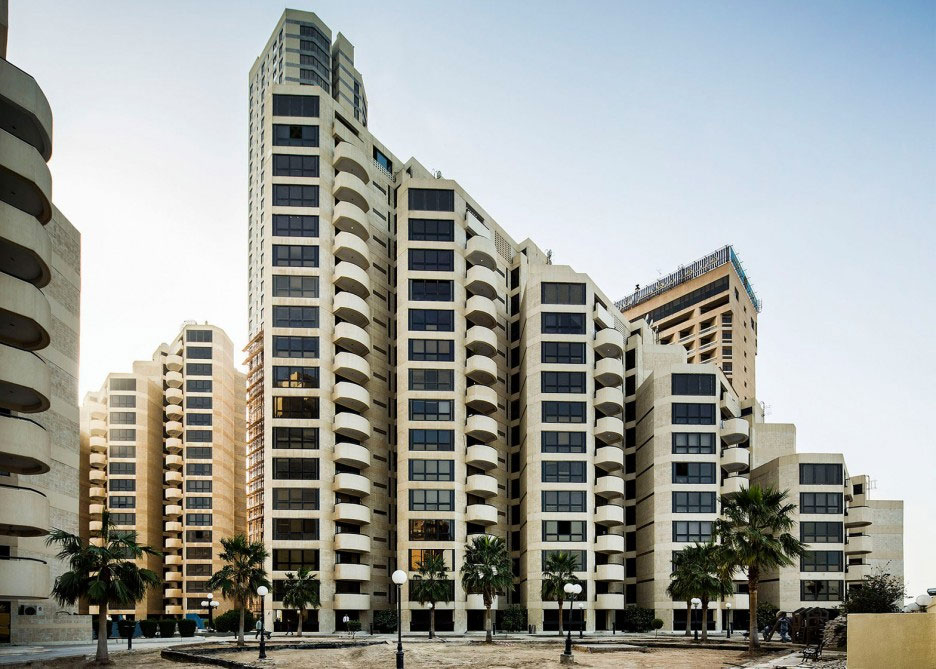
Over the weekend the renowned architect I. M. Pei passed away at the age of 102. He’s behind some of the worlds iconic buildings like the Louvre’s glass pyramid and the Bank of China tower in Hong Kong, but what few people know is that he also designed an apartment building here in Kuwait. Back in the lates 70s I. M. Pei designed what are now the Massaleh towers in Bneid Al Gar. You’ve probably driven past them and never realized the architectural importance of them but I think that applies to a lot of old buildings in Kuwait. In this specific case though, it’s also difficult to find information about these buildings online, most likely because of the age of the project and the different names it goes by. For example, on the I.M. Pei website they’re listed as “Hilton Area Housing” and in the book “Modern Architecture Kuwait” they’re listed as “Hilton Hotel Apartments”.
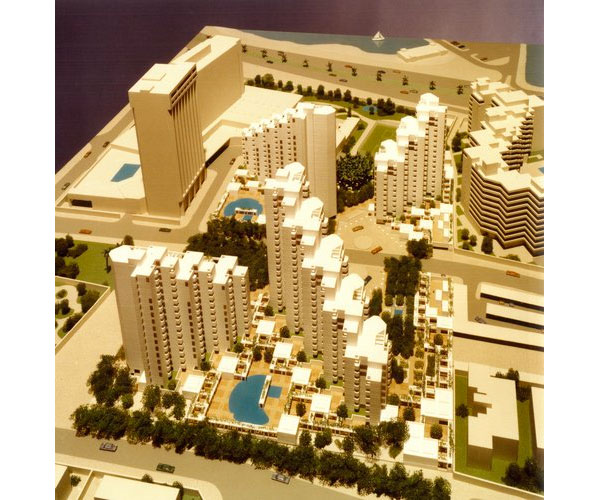
I heard one rumor that the reason there isn’t much information is because I. M. Pei was upset with the project. Supposedly he had originally designed just one tower but then his design was taken and replicated to create the remaining towers. But, don’t think this rumor is very accurate since the model pictured above which contains all four tower blocks is listed on his website as one of his projects.
Here is the link to I. M. Pei’s page of Kuwait projects. There is another project listed there but no idea what that is or if it had ever been constructed.
Photo on top taken by Nelson Garrido
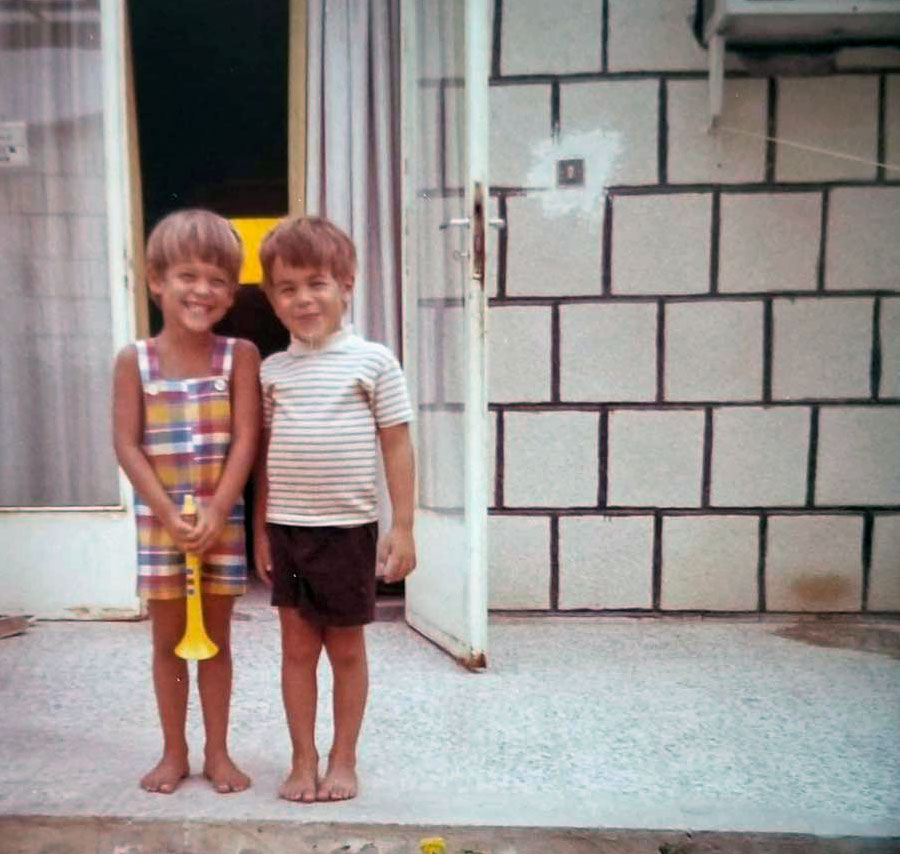
This was published on the Gazelle Club Facebook group and I knew I had to share it here.
Jay Rizzo shown in the first picture with his sister outside one of the Chalets at Gazelle Club, returned later as part of the US Marines who liberated Kuwait in 1991.
Gazelle Club was a very popular beach resort in Kuwait back in the 60s and up until the 1990 Gulf War. During the Gulf War the resort was badly damaged and it was never rebuilt again. You can find more posts about the club by clicking here.
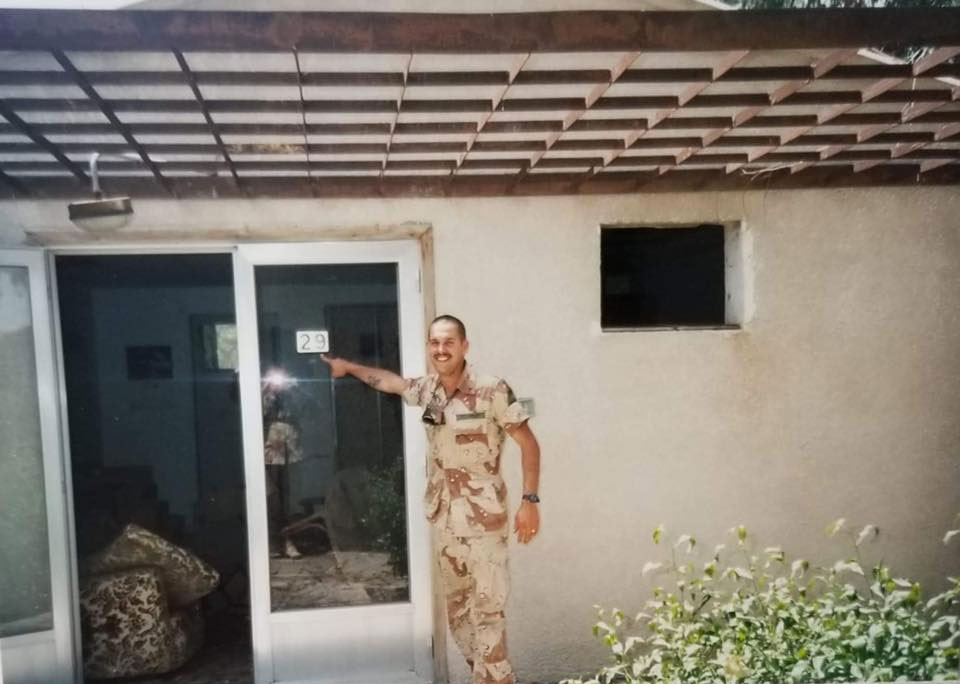
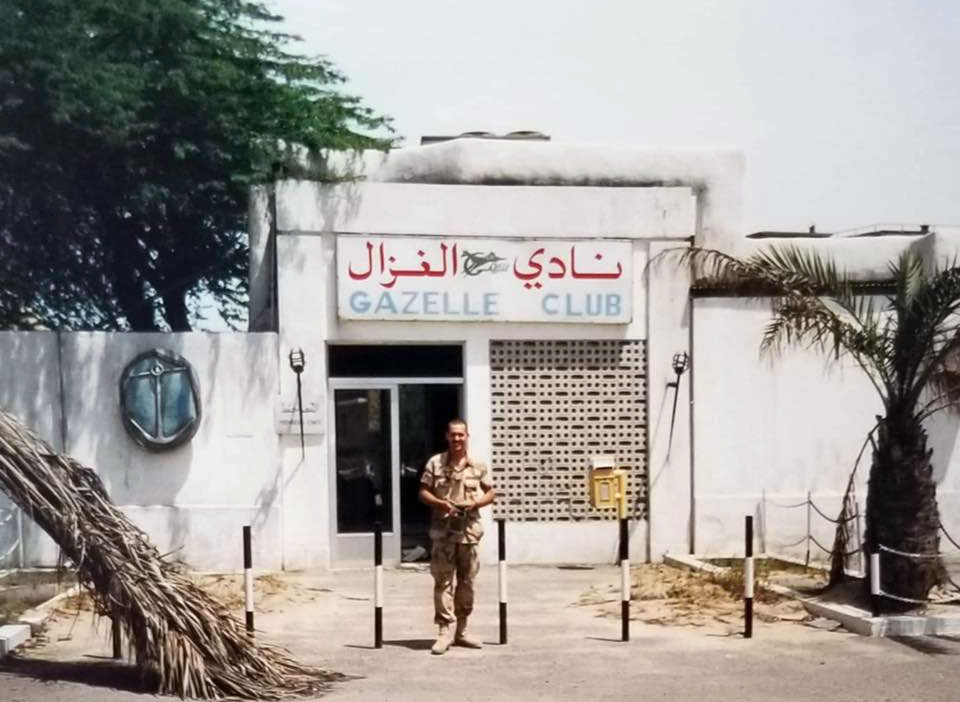

According to the blog Life in Kuwait, the Ahmadi drive-in theater got demolished last week. I guess this isn’t a surprise since it hadn’t been used in decades, but it’s always sad to see another part of Kuwait’s past go.
Next up I hear the ice skating rink is going to get demolished. I’ve been trying to confirm and get more details from TEC but whoever is running their instagram account doesn’t respond to comments or DM’s. So don’t take my word for it.
Anyway, here are some photos of the Ahmadi drive-in:
Ahmadi drive-in when it was being constructed
Ahmadi drive-in from a few years ago